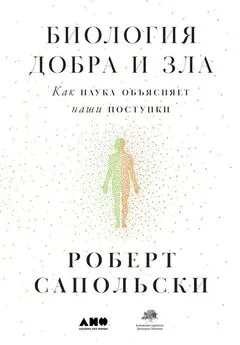Роберт Сапольски - Биология добра и зла. Как наука объясняет наши поступки
- Название:Биология добра и зла. Как наука объясняет наши поступки
- Автор:
- Жанр:
- Издательство:Альпина нон-фикшн
- Год:2019
- Город:Москва
- ISBN:978-5-0013-9051-0
- Рейтинг:
- Избранное:Добавить в избранное
-
Отзывы:
-
Ваша оценка:
Роберт Сапольски - Биология добра и зла. Как наука объясняет наши поступки краткое содержание
Биология добра и зла. Как наука объясняет наши поступки - читать онлайн бесплатно ознакомительный отрывок
Интервал:
Закладка:
441
R. Sjoberg et al., “A Non-additive Interaction of a Functional MAO-A VNTR and Testosterone Predicts Antisocial Behavior,” Neuropsychopharmacology 33 (2008): 425; R. McDermott et al., “Monoamine Oxidase A Gene (MAOA) Predicts Behavioral Aggression Following Provocation,” PNAS 106 (2009): 2118; D. Gallardo-Pujol et al., “MAOA Genotype, Social Exclusion and Aggression: An Experimental Test of a Gene-Environment Interaction,” Genes, Brain and Behav 12 (2013): 140; A. Reif et al., “Nature and Nurture Predispose to Violent Behavior: Serotonergic Genes and Adverse Childhood Environment,” Neuropsychopharmacology 32 (2007): 2375.
442
A. Rivera et al., “Cellular Localization and Distribution of Dopamine D4 Receptors in the Rat Cerebral Cortex and Their Relationship with the Cortical Dopaminergic and Noradrenergic Nerve Terminal Networks,” Nsci 155 (2008): 997; O. Schoots and H. Van Tol, “The Human Dopamine D4 Receptor Repeat Sequences Modulate Expression,” Pharmacogenomics J 3 (2003): 343; C. Broeckhoven and S. Gestel, “Genetics of Personality: Are We Making Progress? Mol Psychiatry 8 (2003): 840; M. R. Munafò et al., “Association of the Dopamine D4 Receptor (DRD4) Gene and Approach-Related Personality Traits: Meta-analysis and New Data,” BP 63 (2007): 197; R. Ebstein et al., “Dopamine D4 Receptor (D4DR) Exon III Polymorphism Associated with the Human Personality Trait of Novelty Seeking,” Nat Genetics 12 (1996): 78; J. Carpenter et al., “Dopamine Receptor Genes Predict Risk Preferences, Time Preferences, and Related Economic Choices,” J Risk and Uncertainty 42 (2011): 233; J. Garcia et al., “Associations Between Dopamine D4 Receptor Gene Variation with Both Infidelity and Sexual Promiscuity,” PLoS ONE 5 (2010): e14162; D. Li et al., “Meta-analysis Shows Significant Association Between Dopamine System Genes and Attention Deficit Hyperactivity Disorder (ADHD),” Human Mol Genetics 15 (2006): 2276; L. Ray et al., “The Dopamine D4 Receptor (DRD4) Gene Exon III Polymorphism, Problematic Alcohol Use and Novelty Seeking: Direct and Mediated Genetic Effects,” Addiction Biol 14 (2008): 238; A. Dreber et al., “The 7R Polymorphism in the Dopamine Receptor D4 Gene (DRD4) Is Associated with Financial Risk-Taking in Men,” EHB 30 (2009): 85; D. Eisenberg et al., “Polymorphisms in the Dopamine D4 and D2 Receptor Genes and Reproductive and Sexual Behaviors,” Evolutionary Psych 5 (2007): 696; A. N. Kluger et al., “A Meta-analysis of the Association Between DRD4 Polymorphism and Novelty Seeking,” Mol Psychiatry 7 (2002): 712; S. Zhong et al., “Dopamine D4 Receptor Gene Associated with Fairness Preference in Ultimatum Game,” PLoS ONE 5 (2010): e13765.
443
M. Bakermans-Kranenburg and M. van Ijzendoorn, “Differential Susceptibility to Rearing Environment Depending on Dopamine-Related Genes: New Evidence and a Meta-analysis,” Development Psychopathology 23 (2011): 39; J. Sasaki et al., “Religion Priming Differentially Increases Prosocial Behavior Among Variants of the Dopamine D4 Receptor (DRD4) Gene,” SCAN 8 (2013): 209; M. Sweitzer et al., “Polymorphic Variation in the Dopamine D4 Receptor Predicts Delay Discounting as a Function of Childhood Socioeconomic Status: Evidence for Differential Susceptibility,” SCAN 8 (2013): 499.
444
F. Chang et al., “The World-wide Distribution of Allele Frequencies at the Human Dopamine D4 Receptor Locus,” Hum Genetics 98 (1996): 91; C. Chen et al., “Population Migration and the Variation of Dopamine D4 Receptor (DRD4) Allele Frequencies Around the Globe,” EHB 20 (1999): 309.
445
M. Reuter and J. Hennig, “Association of the Functional Catechol-O-Methyltransferase VAL158MET Polymorphism with the Personality Trait of Extraversion,” Neuroreport 16 (2005): 1135; T. Lancaster et al., “COMT val158met Predicts Reward Responsiveness in Humans,” Genes, Brain and Behav 11 (2012): 986; A. Caspi et al., “A Replicated Molecular-Genetic Basis for Subtyping Antisocial Behavior in ADHD,” AGP 65 (2007): 203; N. Perroud et al., “COMT but Not Serotonin-Related Genes Modulates the Influence of Childhood Abuse on Anger Traits,” Genes, Brain and Behav 9 (2010): 193. Варианты СOMT также связаны с когнитивными конечными точками: F. Papaleo et al., “Genetic Dissection of the Role of Catechol-O-Methyltransferase in Cognition and Stress Reactivity in Mice,” J Nsci 28 (2008): 8709; F. Papaleo et al., “Effects of Sex and COMT Genotype on Environmentally Modulated Cognitive Control in Mice,” PNAS 109 (2012): 20160; F. Papaleo et al., “Epistatic Interaction of COMT and DTNBP1 Modulates Prefrontal Function in Mice and in Humans,” Mol Psychiatry 19 (2013): 311.
446
D. Enter et al., “Dopamine Transporter Polymorphisms Affect Social Approach-Avoidance Tendencies,” Genes, Brain and Behav 11 (2012): 671; G. Guo et al., “Dopamine Transporter, Gender, and Number of Sexual Partners Among Young Adults,” Eur J Hum Genetics 15 (2007): 279; S. Lee et al., “Association of Maternal Dopamine Transporter Genotype with Negative Parenting: Evidence for Gene X Environment Interaction with Child Disruptive Behavior,” Mol Psychiatry 15 (2010): 548 M. van Ijzendoorn et al., “Dopamine System Genes Associated with Parenting in the Context of Daily Hassles,” Genes, Brain and Behav 7 (2008): 403.
447
D. Gothelf et al., “Biological Effects of Catechol-O-Methyltransferase Haplotypes and Psychosis Risk in 22q11.2 Deletion Syndrome,” BP 75 (2013): 406.
448
M. Dadds et al., “Polymorphisms in the Oxytocin Receptor Gene Are Associated with the Development of Psychopathy,” Development Psychopathology 26 (2014): 21; A. Malik et al., “The Role of Oxytocin and Oxytocin Receptor Gene Variants in Childhood-Onset Aggression,” Genes, Brain and Behav 11 (2012): 545; H. Walum et al., “Variation in the Oxytocin Receptor Gene Is Associated with Pair-Bonding and Social Behavior,” BP 71 (2012): 419.
449
S. Rajender et al., “Reduced CAG Repeats Length in Androgen Receptor Gene Is Associated with Violent Criminal Behavior,” Int J Legal Med 122 (2008): 367; D. Cheng et al., “Association Study of Androgen Receptor CAG Repeat Polymorphism and Male Violent Criminal Activity,” PNE 31 (2006): 548; A. Raznahan et al., “Longitudinally Mapping the Influence of Sex and Androgen Signaling on the Dynamics of Human Cortical Maturation in Adolescence,” PNAS 107 (2010): 16988; H. Vermeersch et al., “Testosterone, Androgen Receptor Gene CAG Repeat Length, Mood and Behaviour in Adolescent Males,” Eur J Endo 163 (2010): 319; S. Manuck et al., “Salivary Testosterone and a Trinucleotide (CAG) Length Polymorphism in the Androgen Receptor Gene Predict Amygdala Reactivity in Men,” PNE 35 (2010): 94; J. Roney et al., “Androgen Receptor Gene Sequence and Basal Cortisol Concentrations Predict Men’s Hormonal Responses to Potential Mates,” Proc Royal Soc B 277 (2010): 57.
450
D. Comings et al., “Multivariate Analysis of Associations of 42 Genes in ADHD, ODD and Conduct Disorder,” Clin Genetics 58 (2000): 31; Z. Prichard et al., “Association of Polymorphisms of the Estrogen Receptor Gene with Anxiety-Related Traits in Children and Adolescents: A Longitudinal Study,” Am J Med Genetics 114 (2002): 169; H. Tiemeier et al., “Estrogen Receptor Alpha Gene Polymorphisms and Anxiety Disorder in an Elderly Population,” Mol Psychiatry 10 (2005): 806; D. Crews et al., “Litter Environment Affects Behavior and Brain Metabolic Activity of Adult Knockout Mice,” Front Behav Nsci 3 (2009): 1.
451
R. Bogdan et al., “Mineralocorticoid Receptor Iso/Val (rs5522) Genotype Moderates the Association Between Previous Childhood Emotional Neglect and Amygdala Reactivity,” Am J Psychiatry 169 (2012): 515; L. Bevilacqua et al., “Interaction Between FKBP5 and Childhood Trauma and Risk of Aggressive Behavior,” AGP 69 (2012): 62; E. Binder et al., JAMA 299 (2008): 1291; M. White et al., “FKBP5 and Emotional Neglect Interact to Predict Individual Differences in Amygdala Reactivity,” Genes, Brain and Behav 11 (2012): 869.
452
L. Schmidt et al., “Evidence for a Gene-Gene Interaction in Predicting Children’s Behavior Problems: Association of Serotonin Transporter Short and Dopamine Receptor D4 Long Genotypes with Internalizing and Externalizing Behaviors in Typically Developing 7-Year-Olds,” Developmental Psychopathology 19 (2007): 1105; M. Nobile et al., “Socioeconomic Status Mediates the Genetic Contribution of the Dopamine Receptor D4 and Serotonin Transporter linkhed Promoter Region Repeat Polymorphisms to Externalization in Preadolescence,” Developmental Psychopathology 19 (2007): 1147.
453
M. J. Arranz et al., “Meta-analysis of Studies on Genetic Variation in 5-HT2A Receptors and Clozapine Response,” Schizophrenia Res 32 (1998): 93.
454
H. Lango Allen, et al., “Hundreds of Variants Clustered in Genomic Loci and Biological Pathways Affect Human Height,” Nat 467 (2010): 832.
455
E. Speliotes et al., “Association Analyses of 249,796 Individuals Reveal 18 New Loci Associated with Body Mass Index,” Nat Genetics 42 (2010): 937; J. Perry et al., “Parent-of-Origin-Specific Allelic Associations Among 106 Genomic Loci for Age at Menarche,” Nat 514 (2014): 92; S. Ripke et al., “Biological Insights from 108 Schizophrenia-Associated Genetic Loci,” Nat 511 (2014): 421; F. Flint and M. Munafo, “Genesis of a Complex Disease,” Nat 511 (2014): 412; J. Tennessen et al., “Evolution and Functional Impact of Rare Coding Variation from Deep Sequencing of Human Exomes,” Sci 337 (2012): 64; F. Casals and J. Bertranpetit, “Human Genetic Variation, Shared and Private,” Sci 337 (2012): 39.
456
C. Rietveld et al., “GWAS of 126,559 Individuals Identifies Genetic Variants Associated with Educational Attainment,” Sci 340 (2013): 1467; J. Flint and M. Munafo, “Herit-Ability,” Sci 340 (2013): 1416.
457
S. Cole et al., “Social Regulation of Gene Expression in Human Leukocytes,” Genome Biol 8 (2007): R189.
458
C. Chabris et al., “The Fourth Law of Behavior Genetics,” Curr Dir Psych Sci 24 (2015): 304; K. Haddley et al., “Behavioral Genetics of the Serotonin Transporter,” Curr Topics in Behav Nsci 503 (2012): 503; F. S. Neves et al., “Is the Serotonin Transporter Polymorphism (5-HTTLPR) a Potential Marker for Suicidal Behavior in Bipolar Disorder Patients?” J Affective Disorders 125 (2010): 98; T. Y. Wang et al., “Bipolar: Gender-Specific Association of the SLC6A4 and DRD2 Gene Variants in Bipolar Disorder,” Int J Neuropsychopharmacology 17 (2014): 211; P. R. Moya et al., “Common and Rare Alleles of the Serotonin Transporter Gene, SLC6A4, Associated with Tourette’s Disorder,” Movement Disorders 28 (2013): 1263.
Читать дальшеИнтервал:
Закладка:





![Роберт Сапольски - Игры тестостерона и другие вопросы биологии поведения [litres]](/books/1074102/robert-sapolski-igry-testosterona-i-drugie-vopros.webp)




